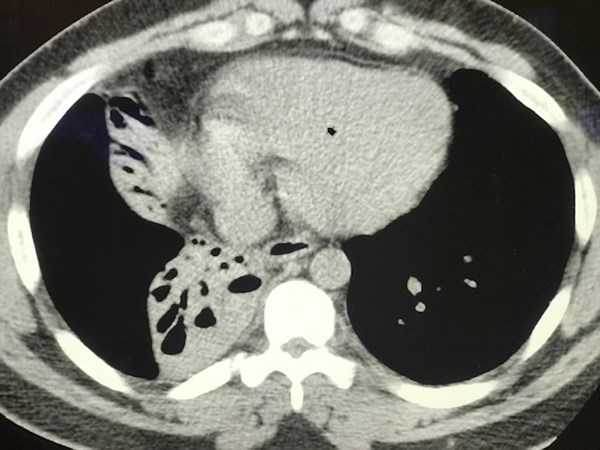Foreign body aspiration is a frequent complaint in the ED. Finding the culprit, however, is not always straightforward.
Case Report
A 29-year-old male with history of pneumonia presents to the ED with complaint of cough. The patient reported he dropped a box he was delivering, releasing a cloud of white powder. The patient states he inhaled the material just prior to arrival in the ED. The box was believed to contain a stove cleaner called "Bar Keepers Friend Cleaner and Polish." The patient reported pleuritic chest pain, cough, dizziness, diaphoresis, nausea, and epigastric abdominal pain following exposure. He has no other pertinent medical history but mentions 2 prior hospitalizations at an outside hospital for pneumonia within the past month.
Physical exam is notable for right lower lobe rhonchi but otherwise unremarkable. Basic labs are only notable for a mild leukocytosis of 12000/ mm3 without bandemia. Chest x-ray shows a right lower lobe infiltrate. CT imaging shows a severely narrowed and occluded bronchus intermedius with collapse of the right lower lobe. Bronchiectasis and/or cavitary changes in the atelectatic right lower lung are seen. In addition, a hyperdensity suspicious for foreign body is noted in the right lower lobe.
These findings are discussed with Pulmonology, who complete a bronchoscopy that reveals a small object, thought to be a piece of bone, removed from the right lower lobe. The patient initially fails extubation immediately following the bronchoscopy and is subsequently transferred to the ICU, where he is treated for aspiration pneumonia with antibiotics and nebulizer treatments. After 3 days, he is weaned and extubated. Review of EMR indicates the patient has not had subsequent ED visits or hospitalizations for pulmonary complaints.
Discussion
Foreign body aspiration is a frequent complaint in the ED. In adults, it is most frequently seen in the elderly and in those with underlying risk factors such as neuromuscular disease, altered mental status, intoxication, and trauma.1 Symptoms are usually acute in onset and involve historical and physical evidence of airway obstruction such as cough, difficulty swallowing, or stridor. However, foreign body aspiration may also have a more indolent course with serious and life-threatening complications.1,2,3,4
The patient in this case was initially brought to the ED for suspected inhalation injury. Poison Control reviewed the contents of Bar Keepers Friend and doubted the symptoms were related to significant inhalation injury. The patient denied any recent history of choking or ingestion foreign bodies. An initial CXR was concerning for an infiltrate in the right lower lobe. Although retained foreign body was low on the differential initially, the exam and CT findings were highly suspicious for pulmonary bronchiectasis, atelectasis, and pneumonia as a result of a possible foreign body.2
The diagnosis of foreign body can be difficult to establish in patients without a clear history, or when presentation occurs weeks to years after the initial aspiration event. While it remains unclear how long this patient's retained foreign body had been present, he mentioned 2 previous admissions at an outside institution for pneumonia in the past month. Cough, fever, and recurrent pneumonia are the most common symptoms in delayed diagnosis of foreign body.2,3
When diagnosis is significantly delayed, patients may develop significant bronchiectasis, bronchial stenosis, asthma, mucosal edema, or recurrent hemoptysis.3 A surgical lobectomy may be warranted if extraction of foreign body is unsuccessful or when sequela of foreign body aspiration has resulted in extensive damage to pulmonary tissue.3
Consider a delayed presentation of foreign body aspiration in those presenting with chronic cough and recurrent pneumonia. Radiologic findings include pneumonia, bronchiectasis, and atelectasis, but may not show evidence of obvious foreign body, but bronchoscopy can be both diagnostic and therapeutic.
TAKE-HOME POINTS
- While foreign body aspiration is often seen promptly after initial event, delayed diagnosis of foreign body should be considered in patients with recurrent cough and/ or recurrent pneumonia that has been unresponsive to antimicrobial therapy.
- Undiagnosed and retained foreign bodies may result in serious complications such as pneumonia, bronchiectasis, and atelectasis.
- Removal of retained foreign body requires bronchoscopy for both diagnosis and treatment. If extraction is extensive or pulmonary disease is severe, surgical evaluation may be necessary.
References
1. Alharthi BJ, Masoodi I, Almourgi MA, Alzahrani S. Occult foreign body in the lung mimicking bronchogenic carcinoma. BMJ Case Reports. 2014;pii: bcr2014207438.
2. Boleken ME, Kaya M, Ozturk A, Kanmaz T, Yücesan S. Initial temporary misdiagnosis of bronchiectasis following pumpkin seed aspiration. Prim Care Respir J. 2007;16(6):384-386.
3. Reddy RZ, Carter YM, Hsia DW. Successful Removal of a Chronic Aspirated Foreign Body after Twelve Years. Case Rep Pulmonol. 2018;8241591.
4. Shekar SP, Bajarano P, Hadeh A, et al. Case of Missing Plastic: Foreign Body Bronchiectasis. Cureus. 2018;10(7):e2974.



